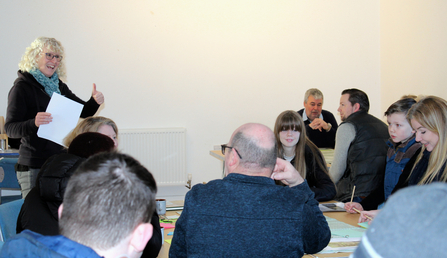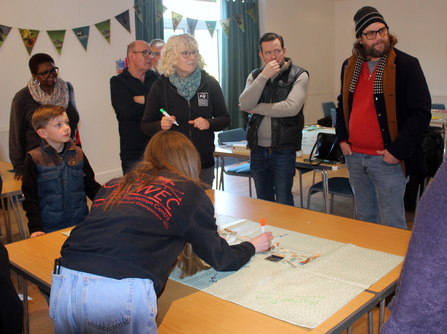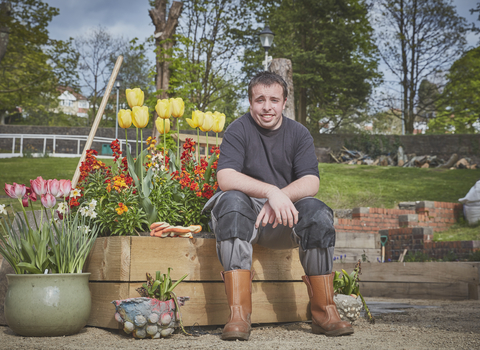Running a group session: how to get started
Photo copyright Autumn Barlow / The Wildlife Trusts 2024
This guide is about a better way of holding meetings
How do you make sure everyone gets listened to? How do you make it worth your time? How do you get to a decision?
This guide is long. It is split into the following sections:
- Introduction
- What does a facilitator do?
- Who can be a facilitator?
- Other people at the meeting can take on jobs
- Preparing the meeting
- Starting the meeting
- During the meeting
- At the end of the meeting
- Other resources
Nextdoor Nature - Norton Quaker Meeting House (https://www.youtube.com/watch?v=dSiEEG_C3E4)
Watch members of Norton Quaker Meeting House come together to plan a place for nature on their grounds.
Introduction
It can be hard to get a group of people to agree on what to do. The usual, or traditional, way is to make one person a leader – often called the chair or chairperson. The chair listens to everyone else then they make a decision or there is a vote. The problem with this is that people who are confident at speaking or who speak the most or the loudest will be heard. But quiet people, who also have good ideas, don’t get to share.
Instead of a chair, there is a “facilitator.” They are not in charge. They just make sure that everyone gets heard fairly.
This is called “consensus decision making.” This means that everyone gets to decide and agree on the outcomes.
An “agenda” is a list of things that the people at the meeting want to discuss. Often, the facilitator will ask people beforehand if there is anything they want to talk about, and then the facilitator “sets the agenda”. They will send it to everyone before the meeting. There will be some time at the end called “AOB” or “any other business.”
An “action point” comes out of the discussion and it means that something needs to be done. It is written down along with the person who has to do it, and the date they will do it.
“Minutes” are notes of what has been said. They can also make sure that action points are properly written down and the right person is given the job.
What does a facilitator do?
The facilitator keeps the timings so that everything on the agenda has enough time to be discussed properly.
The facilitator makes sure everyone has a chance to speak, and one person doesn’t speak too much. Tips for doing this are below.
The facilitator might sum up the key points and repeat them to the group. This checks that everyone understands before they make a decision.
The facilitator watches for conflict and helps the group deal with it.
The facilitator makes sure that any action points and decisions are written down, but they might ask someone else to do the writing.
Before the meeting, the facilitator needs to check accessibility. If the meeting is online, is that suitable for everyone? Does there need to be closed captions? If the meeting is in person, are there steps? Accessible toilets? A baby change facility? Is there a way of having people attend online too?


Who can be a facilitator?
Anyone! But don’t assume that it is “easy” or that some people can do it “naturally.”
It is a skill that you can learn, and you can get better at.
It is good to let different people in the group be a facilitator and take it in turns. You might be able to find training on it – speak to your local Voluntary Services network.
You can learn how to be a good facilitator by just being in meetings and watching and listening. What is going well? How could things be better?
You will need these essential skills, but anyone can get better at these things:
- Respect everyone – be interested in everyone but be neutral. You cannot take sides. If it is something you feel strongly about, make it clear when you are expressing an opinion. If it is a very important topic to you then you should step aside and let someone else facilitate.
- Good listening skills – use open questions. A closed question can only be answered with “yes” or “no” (Do you like cake?) but an open question has to be answered with information (What do you like to eat?)
- Assertiveness and confidence – sometimes you will have to be firm with people.
- Paying attention to what is going on. If you have neurodivergency or different thinking skills, you may need to draw on some of your established coping mechanisms to help you stay on track but this should not stop you being a good facilitator.
Other people at the meeting can take on jobs, too
Timekeeper – they will have the agenda and make sure discussions stick to the timings
Minute takers – they take notes of everything that is said
Doorkeepers – useful in large meetings or ones that are open to the public. If someone arrives late, the doorkeeper can greet them, tell them the meeting has started, and show them to a seat without disturbing the meeting.


Photo copyright Autumn Barlow / The Wildlife Trusts 2024
Preparing for a meeting
You can split these jobs up. The facilitator doesn’t need to do everything. Make sure you note who is doing what.
Find a place to meet (“venue”).
Agree on the best time to meet (do people need to look after their children? Do people work? You will need to think about the people who are coming, and talk to them about the best time for the most people, but you can never make absolutely everyone happy).
Make sure it is accessible for everyone.
Prepare the agenda.
Gather any materials that are needed. Do you need a flipchart, pens, a camera?
Have a back-up facilitator! Don’t rely on one person. Things happen!
Starting the meeting
Welcome everyone and let people know where the toilets and fire exits are.
Some people will do an icebreaker at this point. This depends on your group as many people say they dislike them. At least, however, offer everyone the chance to introduce themselves. It can be helpful to introduce yourself first, to set the pattern, and to offer your pronouns (are you she? He? They? Or another pronoun?) but make it clear that people do not need to offer their own, as some people will not feel comfortable doing that.
Set some guidelines. Tell everyone what the meeting is about and explain how the meeting will run, and if you have printed off an agenda, give that out. Agree with the group if there is some behaviour that is not acceptable. You can write up the group agreement so everyone can see it.
During the meeting
If you don’t have a separate timekeeper, you will keep the meeting on track.
Go through the agenda one by one.
Make sure that action points are written down and that someone is given the task. But keep an eye on this – don’t let everything fall onto one person.
Keep everyone talking and make sure that everyone gets heard. You might need to ask someone who has done a lot of talking to let someone else speak first.
Be positive and let everyone know that they are appreciated.
Challenge discriminatory and hurtful language immediately, but respectfully. Call out the behaviour, not the person.


Photo copyright Autumn Barlow / The Wildlife Trusts 2024
At the end of the meeting
Make sure that the minutes or notes are written up and will be sent to everyone who was at the meeting.
Agree a time and place for the next meeting.
Sum everything up if you can. Remind everyone who has been given a job – an action point – of what they have agreed to do.
You could ask for evaluation – this just means ask people what went well about the meeting and what could be better.
It’s nice to finish on something social. Sharing a meal or some refreshments, for example.
Other information
A really good resource is here on Seeds For Change. It also has advice on how to summarise/sum up, how to listen, and how to work with larger groups. It also has help for when things go wrong.
The Seeds for Change website also has a page of tools for meetings. These are activities and ways of running a meeting.
A short summary of running a meeting is here. This is a useful reminder of the key points.
Bradford VTS is a difficult website to use, but they have a great list of resources.


The Wildlife Trusts
Have you been part of a community nature project?
We'd love to hear from you! Your experiences will be shared right here on the Community Hub and will inspire others to take action in their own neighbourhoods.


CC by 4.0 attribution
Except where noted and excluding images, company and organisation logos, this work is shared under a Creative Commons Attribution 4.0 (CC BY 4.0) Licence.
Please attribute as: “Nextdoor Nature (2022-2024) by The Wildlife Trusts funded by The National Lottery Heritage Fund, licensed under CC BY 40”



